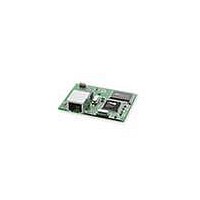20-101-1112 Rabbit Semiconductor, 20-101-1112 Datasheet - Page 113

20-101-1112
Manufacturer Part Number
20-101-1112
Description
MODULE RABBITCORE RCM4010
Manufacturer
Rabbit Semiconductor
Datasheet
1.20-101-1094.pdf
(130 pages)
Specifications of 20-101-1112
Module/board Type
MPU Core Module
Product
Microcontroller Modules
Core Processor
Rabbit 4000
Clock Speed
58.98 MHz
Interface Type
Ethernet, Serial
Flash
512 KB
Timers
10 x 8 bit, 1 x 10 bit, 1 x 16 bit
Operating Supply Voltage
3 V to 3.6 V
Board Size
47 mm x 61 mm x 20 mm
Core
RCM4010
Processor Series
RCM4000
Silicon Manufacturer
Rabbit
Core Architecture
Rabbit 4000
Silicon Core Number
RCM4010
Silicon Family Name
RCM4000
Kit Contents
Board
Development Tool Type
Hardware / Software - Dev Kit (Dev Tool)
Rohs Compliant
Yes
For Use With/related Products
RCM4010
Lead Free Status / RoHS Status
Lead free / RoHS Compliant
Other names
Q3413688
Many other possible ranges are possible by physically changing the resistor values that
make up the attenuator circuit.
It is also possible to read a negative voltage on LN0_IN–LN5_IN by moving the 0
jumper (see Figure B-6) on header JP23 or JP24 associated with the A/D converter input
from analog ground to the reference voltage generated and buffered by the A/D converter.
Adjacent input channels are paired; moving the jumper on JP 23 changes both of the
paired channels (LN4_IN–LN5_IN), and moving the jumper on JP24 changes LN0_IN–
LN3_IN. At the present time Rabbit does not offer the software drivers to work with single-
ended negative voltages, but the differential mode described below may be used to measure
negative voltages.
Differential measurements require two channels. As the name differential implies, the dif-
ference in voltage between the two adjacent channels is measured rather than the differ-
ence between the input and analog ground. Voltage measurements taken in differential
mode have a resolution of 12 bits, with the 12th bit indicating whether the difference is
positive or negative.
The A/D converter chip can only accept positive voltages, as explained in Section 4.4. Both
differential inputs must be referenced to analog ground, and both inputs must be positive
with respect to analog ground. Table B-4 provides the differential voltage ranges for this
setup.
User’s Manual
Min. Differential
Voltage
NOTE: Analog input LN7_IN does not have the 10 k resistor installed, and so no
(V)
0
0
0
0
0
0
0
0
resistor attenuator is available, limiting its maximum input voltage to 2 V. This input is
intended to be used for a thermistor that you may install at header location JP25.
Max. Differential
Voltage (with
prescaler)
Table B-4. Differential Voltage Ranges
±22.528
±11.264
±5.632
±4.506
±2.816
±2.253
±1.408
±1.126
(V)
Multiplier
Gain
×10
×16
×20
×1
×2
×4
×5
×8
A/D Converter
Actual Gain
14.4
1.8
3.6
4.5
7.2
9.0
18
1
Resolution
(mV)
1.375
1.100
0.688
0.550
2.75
2.20
5.5
11
107

















